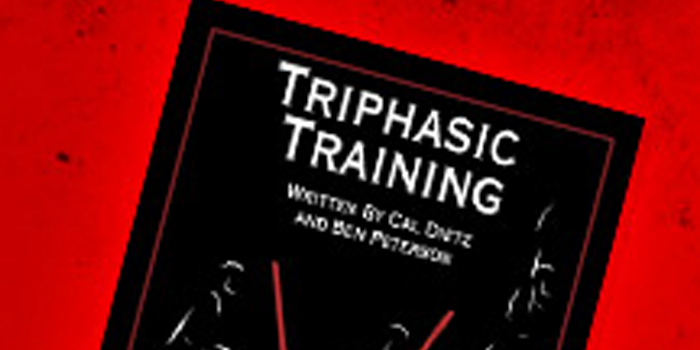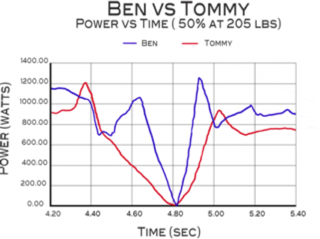
I just finished reading Triphasic Training by Cal Dietz and Ben Peterson. In the book, Dietz discusses how to build the base of an athlete using three specific components—eccentric, isometric and concentric. In this article, I'll discuss a portion of his philosophy and how he explains the importance of dynamic movement.
All athletic moment is dynamic. Dynamic movement involves eccentric, isometric and concentric components. Therefore, athletic movement equals dynamic movement equals triphasic movement.
Image via Triphasic Training
Looking at the model above, Ben and Tommy (shot putters) had the same bench max (strength). Using a force plate to measure some data, they found that Ben was able to absorb more force eccentrically faster and then recoil to a concentric motion at a dime. Because the isometric is at a finer point (more of a V), it is harder to find. This means that you're exploding or transitioning more quickly.
During a maximal effort in dynamic contraction, you'll never see the eccentric portion of the V at a shallower angle than the concentric portion. The body can’t generate more force than it can absorb maximally, unless that body was deliberately jerked. But even so, no athlete (at the elite level anyway) gives less than 100 percent in competition. Cal and Ben also believe that the neuron pathway in charge of signaling these three contractions are all substantially different (long story short) enough that they need to be trained independently before you put them together dynamically.
Eccentric
The muscle spindle's primary function is to tell the brain how hard it must contract to overcome a load. Regardless of the load, the brain can't differ between a weight being lifted or a cut on the field. Because every movement begins with an eccentric movement, this is a primary focus and, in my opinion, important for injury prevention
The main function of the Golgi tendon organ (GTO) is to say “there are too many motha f$*&ing snakes on this mutha*&^%ing plane!” Nah, I’m kidding, but it will really say, “Don’t lift that stuff—you’ll get hurt,” and the body will perform an emergency cut off switch to shut down. This will automatically decrease muscle tension to prevent serious injury to the muscle structure. But this “kill switch” set by the GTO is set nearly 40 percent below what the structure can actually handle before serious damage, so using this phase can help desensitize it.
The eccentric phase is the most taxing on the central nervous system (CNS), which is why these come into play.
Isometric
I like how it says that it's more of a joint angle in a fixed position instead of a muscle remaining constant. Muscle moves constantly and is never in a state of non-movement. It has two neurological processes that need to be trained to maximize the force transfer from the eccentric to concentric contractions—motor unit recruitment and rate coding.
Motor recruiting will occur instantly if you apply a faster velocity of eccentrics to an abrupt stop. The neurons are arranged from smallest to largest. Type I fibers are at the left while type II fibers are at the right. So the goal is to turn those guys on, like when you hit a sledge hammer on that carnival game with the lights. By improving the isometric strength of athletes through muscle recruitment, you're activating larger type II fibers.
Because the signaling of a neuron never changes, it increases the frequency of the signal in order to increase the contraction. A signal is a twitch and you throw a crap load of twitches to create a “tetanus,” which would be a simultaneous amount of stimulation. This would be your maximal force production. The reason why this is important, specifically here, is that you need to make the weight eccentrically going down come to a complete stop. The harder the stop, the better the recoil from the stretch reflex and stretch shortening cycle and therefore a more explosive dynamic action. You want to bounce the ball off the concrete wall, not the sand. This goes into hand with the data above with the "V" shape at the bottom. The finer the point, the quicker the transition from eccentric to concentric force. If dull, it is a ball in the sand, slow and dissipating the energy.
Concentric
This is the most focused on but never realized. What now occurs is the synchronization of all qualities listed above working together. With that being said, the coordination isn't anything special without maximal rate of force development.
Reactive ability is the "ability to rapidly generate explosive force resulting from a preliminary dynamic stretch followed instantly by a subsequent contraction.” This is a more specific word to describe the rate of force development. The two qualities gained in this phase are inhibition/disinhibition and synchronization.
The body is always helping to protect the body. It does this by having the antagonist eccentrically contract while the agonist concentrically contracts. Just like the GTO, it needs to be detrained. If we train the muscles to move fast, we will reduce this quality. To train the concentric phase, the athlete is also training the inhibition of the antagonist (relaxing it). The best athletes are able to not only contract at high velocities but relax at superior velocities.
From here on now, everything will be reactive or the bar moving down and up fast. With that being said, "A well-trained concentric phase is the organization of chaos into a deliberate, focused application of force.” Fire all the muscles provided for the lift in sync and fire high threshold motor units. In the book, Dietz explains in more detail what it's about, but it makes sense—a high rate of force development through the entire range of motion, maximizing energy transfer from the stretch reflex to the concentric and stretch shortening cycle.
To wrap it up, the philosophy aims to start with a base of each component—eccentric, isometric and concentric. There is way more to the book and the philosophy of transitioning and peaking, but this one part gives you a different perspective in what we see every day in our jobs, like when you finally notice the arrow inside the FedEx logo. It's almost like an "a-ha" moment.
James Carr graduated from California University of Pennsylvania with a degree in sports management. He earned his CSCS from the NSCA in 2014. He is a performance coach for EM Training in Rancho Cucamonga, California, where he trains mostly the softball, baseball and football population.










